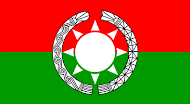|
|
Tinnang labau gawn/matsing da mayu ai ni a matu.
Kalang lang gaw tinnang a tinnang kaji kadun ai amyu,
hpaji nkung shi ai amyu,
awm dawm nlu ging shi ai amyu ngu myit dat shagu anhte a Jiwoi Jiwa ni a labau hte
du magam myit ni hpe gawn dinglik yu ga.
CIA Headquarters hta nga ai anhte amyu sha ni a sumla a lam kadun re.
https://www.cia.gov/news-information/featured-story-archive/2010-featured-story-archive/irrawaddy-ambush.html
In fall 2010, the Center for the Study of Intelligence and the Fine Arts Commission unveiled a painting titled “Irrawaddy Ambush” by Stuart Brown. The new addition to the Intelligence Art Collection depicts Detachment 101 of the Office of Strategic Services (OSS) —the predecessor of today’s CIA — in Burma during World War II. Mr. Michael DeSombre donated the painting to CIA in tribute to the work of today’s National Clandestine Service.
The Story Behind the Painting
The painting illustrates one of Detachment 101’s many guerrilla operations staged to disrupt Japanese supply and reinforcement routes in Burma. Staked out on one side of the Irrawaddy River, OSS-trained Kachin rangers ambush Japanese rafts bringing troops and supplies to the Japanese-held town of Myitkyina in July 1944. Such actions helped lead to the Allied re-capture of the town and, ultimately, to the defeat of Japanese forces in northern Burma.
During World War II, the Burma Road in northeast Burma was a lifeline for the Nationalist Chinese fighting the Japanese. A primary reason for the Japanese invasion of Burma, which was a British colony at the time, was to cut this supply link. The Imperial Army accomplished this task by the summer of 1942. The Allies then began airlifting materiel from India to China through the Himalayas, all the while trying to reopen the road.
The Creation of Detachment 101
In April 1942, Coordinator of Information and future OSS Director William J. Donovan activated Detachment 101 to create an indigenous guerrilla force charged with gathering intelligence, harassing the Japanese occupiers, identifying bombing targets for the Army Air Force, and rescuing downed Allied airmen—all deep behind enemy lines in Burma. Detachment 101 pioneered the art of unconventional warfare, foreshadowing the missions of today’s U.S. Army Special Forces.
Never more than a few hundred Americans strong, Detachment 101 relied on support from various Burmese tribal groups, most notably the staunchly anti-Japanese Kachins. Combined with the efforts of the British Wingate’s Raiders, Merrill’s Marauders of the U.S. Army, and Nationalist Chinese troops, Detachment 101 was so successful that Japan had to divert significant numbers of troops to Burma to protect the new railroad that it had built to move supplies overland after U.S. Navy submarines had blocked Japanese shipping routes.
By the time of its deactivation in July 1945, OSS Detachment 101 had amassed an impressive list of accomplishments, performing against overwhelming enemy strength and under the most difficult and hazardous conditions. The courage and fighting spirit of the Kachin guerrillas and their American advisors earned Detachment 101 a Presidential Unit Citation and recognition as the “most effective tactical combat force” in the OSS.
“Irrawaddy Ambush” contributes an impressive representation of a critical aspect of OSS history. At the unveiling, CIA Museum Director Toni Hiley noted, “The Story of OSS must be kept fresh and vibrant, not only for the sake of the patriots who lived it, but for all who continue the vital missions begun decades ago by that remarkable organization of remarkable Americans.”
The painting is now on display in the Intelligence Art Gallery, in the Original Headquarters Building.
Related Stories and Links:
Historical Document
Posted: Dec 16, 2010 09:45 AM
Last Updated: Apr 30, 2013 12:42 PM









.jpg)